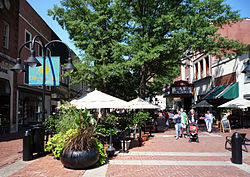 The Downtown Mall with Paramount Theater in the background. | |
 | |
| Location | Charlottesville, Virginia |
|---|---|
| Coordinates | 38°01′49″N78°28′48″W / 38.0303°N 78.4800°W |
| Address | East Main Street |
| Opening date | 1978 |
| Architect | Lawrence Halprin |
| Stores and services | 40 |
| Website | friendsofcville |

The Downtown Mall in Charlottesville, Virginia, is one of the longest pedestrian malls in the United States. [1] Located on Main Street, it runs from 6th St. N.E. to Old Preston Ave., where it extends to Water St., for total length of eight blocks. It is laid with brick and concrete, and home to an array of restaurants, shops, offices and art galleries. On Fridays in the spring, summer and fall, the Downtown Mall is host to Fridays After Five, a weekly concert series. Several side streets are also paved in brick and likewise closed to traffic. On the east, the Mall ends at the Ting Pavilion, an outdoor concert venue, while the west end of the Mall features an Omni Hotel. It is also home to the newly renovated Paramount Theater and the historic Jefferson Theater.